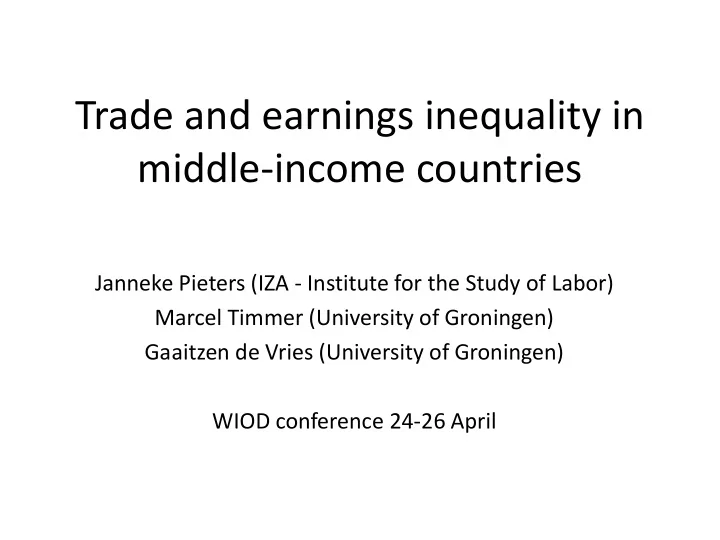

Trade and earnings inequality in middle-income countries Janneke Pieters (IZA - Institute for the Study of Labor) Marcel Timmer (University of Groningen) Gaaitzen de Vries (University of Groningen) WIOD conference 24-26 April
Introducing • Trade and inequality in developing countries: challenges for H-O theory, ongoing debate (Golberg and Pavcnik JEL2007; Harrison et al. 2011) • Rising skill premium in many developing countries, most changes within industries • Within-industry inequality & trade, in line with quality upgrading (Verhoogen, QJE2008): Southern exporters produce higher quality goods for foreign market • We explore the role of trade in changing relative demand for different worker types (education): cost-share analysis
• Recent evidence: trade liberalization periods • Brazil 1988-1995 Gonzaga et al (JIE 2006) trade liberalization accounted for declining skill premium (tariff reductions falling prices in skill-intensive sectors, employment shifts) • India 1980-1998 Chamarbagwala & Sharma (JDE 2011): capital-skill and output-skill complementarities within formal manufacturing firms, but strongest pre-liberalization Berman et al (2006): capital-skill and output-skill complementarity within formal manufacturing industries, no effect of imports or exports
• Contributions • Six middle-income countries (focus on Brazil and India) • WIOD data 1995-2009 • All sectors of the economy • Foreign final demand, share in value added
Wage-bill shares middle-income countries Total economy: high-skilled share in total wage bill .4 .3 LABHS .2 .1 0 1995 2000 2005 2010 year country = BRA country = CHN country = IDN country = IND Source : WIOD and country = MEX country = TUR NSSO India
Total economy: medium-skilled share in total wage bill .6 .5 LABMS .4 .3 .2 1995 2000 2005 2010 year country = BRA country = CHN country = IDN country = IND Source : WIOD and country = MEX country = TUR NSSO India
Total economy: low-skilled share in total wage bill .6 .5 LABLS .4 .3 .2 .1 1995 2000 2005 2010 year country = BRA country = CHN country = IDN country = IND Source : WIOD and country = MEX country = TUR NSSO India
Within- and between-industry changes Share of high-skilled labor 1995-1999 1999-2004 2004-2009 within between within between within between BRA 0.02 0.00 0.02 -0.02 0.03 0.00 CHN 0.01 0.01 0.03 0.01 0.03 0.01 IDN 0.00 -0.02 0.04 0.02 0.11 0.00 IND 0.01 0.00 0.05 -0.01 MEX -0.01 0.00 -0.01 0.01 -0.04 0.01 TUR 0.03 0.02 0.03 -0.01 0.03 0.02
Share of medium-skilled labor 1995-1999 1999-2004 2004-2009 within between within between within between BRA 0.01 0.00 0.01 0.00 0.01 0.00 CHN 0.03 0.03 -0.01 0.01 -0.03 0.01 IDN 0.01 -0.01 0.02 0.01 -0.08 -0.01 IND 0.02 0.00 0.00 0.00 MEX 0.03 0.00 0.04 0.00 0.06 0.00 TUR 0.00 0.00 0.02 0.00 0.02 0.00
Trade and skill demand International production fragmentation requires new measures of international trade to examine the effects of globalization on skill demand The amount of value added produced in a given source country that is ultimately embodied in final goods absorbed abroad (Bems et al., 2011): va_exp = diag( r) ( I – A ) -1 c j where r is the ratio of value added to output for each sector in each country, and c j is the vector of final demand for country j
Foreign earnings, share in GDP 0.40 0.35 0.30 0.25 0.20 0.15 0.10 0.05 0.00 China Brazil India Mexico Turkey Indonesia -0.05 1995 value added export to GDP ratio change from 1995 to 2008
Cost function approach (Feenstra, 2004) For each industry i = 1, …, I in country c = 1, …, C we consider a production function: VA ic = f ic (L ic , M ic , H ic , K ic ) (1) The (short-run) cost function, obtained when the levels of capital and output are fixed but labor is flexible, is defined as: C ic (w Lic , w Mic , w Hic , K ic , VA ic ) = min{ w Lic L ic + w Mic M ic + w Hic H ic }, (2) subject to equation (1).
Econometric specification Taking differences between two periods, the econometric model is given by: Where: s cost share K capital VA value added FD foreign earnings
Summarizing Descriptive analysis of skill demand in emerging markets challenges H-O: • Rising wage bill share for high-skilled workers • Within-industry skill upgrading At the same time, increasing international fragmentation of production challenges conventional trade statistics: • Measure income earned abroad due to participation in value chains • Aim: relate foreign earnings to changing skill demand Thank you pieters@iza.org g.j.de.vries@rug.nl
Recommend
More recommend